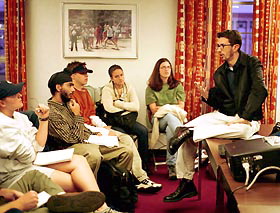|
This is an archived article.
For the latest news, go to the Advance
Homepage
For more archives, go to the Advance Archive/Search Page. | ||
|
Events
of September 11 Launched
New Era for Media, Say Panelists
"It would be hard to fault the news media's coverage in the first week to 10 days," said Marcel Dufresne, an associate professor of journalism and moderator of the panel discussion, "September 11 and Beyond: A View from the Newsroom." The event, which took place on November 14, was part of Metanoia.
As a result of the September 11 terrorist attacks, Bethe Dufresne, a news columnist at The Day of New London, began focusing on Islamic-Jewish relations and nuclear power plants. She attempted to find former nuclear activists from the 1980s and solicit their views on terrorism and the potential threat to the power plants. Dufresne said she chose not to write about much of what she heard, out of fear that such a column would give people ideas. Dufresne had written about relations between the Islamic and Jewish communities before the attacks. After September 11, Muslims in southeastern Connecticut went on the offensive, she said, in an attempt to make sure their point of view was covered. That strategy, as well as a number of forums on Muslim issues, may have helped prevent some harassment, she added. Tom Scheffey from the Connecticut Law Tribune recalled watching the collapse of the World Trade Center in his publisher's office. He knew immediately that the terrorist attacks would affect the paper. "No matter what publication you're working for, this is going to be the story," Scheffey said. "It was an unprecedented event." Immediately after the attacks, Scheffey began calling lawyers with different areas of expertise - from litigation and civil rights to aviation disaster - to get their reactions and opinions. Jay Clendenin, a Hartford Courant photographer, found out about the attacks when a friend called him at home and told him to turn on his television. Minutes later, he was on his way to New York to photograph the aftermath. Because of road closures, Clendenin only made it as far as Jersey City on September 11. From there, he took his first photographs using a digital camera and transmitted them to the newsroom by computer. "Digital photography played the biggest role in what you saw, from day one," he said. Clendenin spent about two weeks photographing events in New Jersey and New York. Though he never made it to ground zero, Clendenin took scores of pictures. Many of them later appeared in a special section in the Courant called "From the Perimeter." The panelists agreed that journalists have reacted appropriately to the events of September 11. "I think that the media in general has done a good job," said Bethe Dufresne, noting that the coverage before September 11 was often trivial. Allison Thompson |
 ust as it did for the rest of the country, September 11
changed everything for members of the news media, who found
themselves covering first an unprecedented breaking news story and
then a war. According to a panel of journalists, the media coverage
has proven that they're up to the challenge.
ust as it did for the rest of the country, September 11
changed everything for members of the news media, who found
themselves covering first an unprecedented breaking news story and
then a war. According to a panel of journalists, the media coverage
has proven that they're up to the challenge.
